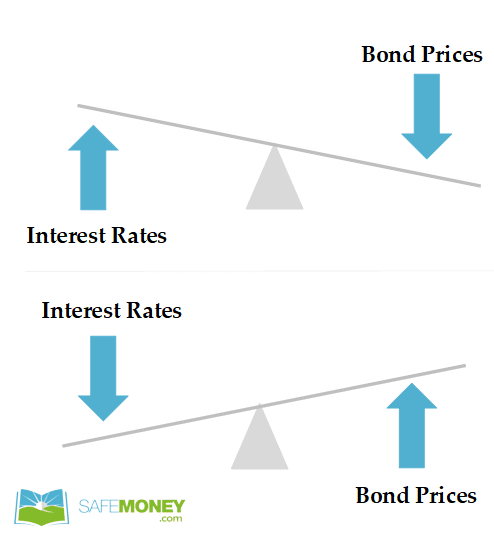What Is Interest Rate Risk?

Turn on the TV or radio, and chances are you might hear of volatility hitting equity markets at some time or another. But what you might not hear as much about is the risk facing CDs, bonds, Treasury securities, and other fixed-interest holdings: interest rate risk.
What is interest rate risk? It’s a particularly important topic for retirees. After all, many retirement portfolio strategies use fixed-interest holdings to generate stable retirement income or to smooth out volatility in a portfolio.
These fixed-income assets also tend to be the place where millions of Americans protect their money. Or they may park cash there for short-term to medium-term goals. So, long story short, interest rate risk can have implications for millions of people
So, how should we define interest rate risk — and how might affect you? Let’s get into it.
How Does Interest Rate Risk Work?
Simply put, interest rate risk is the probability of an interest-earning asset losing value due to changing interest rates. This risk directly affects the value of fixed-income holdings.
Since many portfolio strategies include bonds, many advisors and pundits use the example of a bond to explain this risk in real-world terms. Interest rates and bond prices are inversely related.
When interest rates increase, the risk tied to that increase also goes up. As a result, bond prices fall.
What about when interest rates drop? The risk associated with the drop also goes down. As a result, bond prices will tend to increase in value.

How Can Interest Rate Risk Affect Asset Values?
Say someone buys a 10-yr bond with a fixed rate of 2.5% for $20,000. The bond will pay them $500 per year until the bond matures.
If interest rates were to rise to 3% during this time, newly issued bonds would pay $600 per year until maturity. Of course, that assumes that someone paid $20,000 into the new bond and the bond also had a 10-year duration.
If the 2.5% bondholder continued to keep his bond until maturity, he would miss out on opportunities to earn more interest with the higher-paying bonds at 3%.
Of course, our bondholder could also choose to capitalize on the moment. They could sell their 2.5% bond and buy the bond paying 3%.
But since there are bonds in the market with a higher interest rate, the 2.5% bond wouldn’t be as attractive to potential bond buyers. Hence the bondholder would receive a lower price on their 2.5% bond, as a result.
Now, why does this matter for retirees? It’s important particularly to those who are using fixed-interest holdings to preserve their money or to generate reliable retirement income.
An Answer to Interest Rate Risk for Retirement Income?
As Dr. Wade Pfau points out, fixed and indexed annuities aren’t subject to interest rate risk in the same way that bonds as well as other fixed-income assets are.
Yes, you might not get as good a “deal” for your money with a fixed or indexed annuity when interest rates are low, compared to when they might have been higher in the past.
That is because the underlying investments supporting these contracts are mostly fixed-interest holdings. Treasury securities, bonds, and mortgage holdings are just a few of the underlying insurer assets that might be subject to interest rate risk.
But life insurance companies also manage the risks tied to annuity contracts in ways that individual bondholders, or even bond fund managers, can be hard-pressed to duplicate.
How? Because insurance companies bake “mortality credits,” or actuarial estimates of the expected mortality for each of their policyholders, into every annuity payout.
These calculations help the insurer better manage the risks it has insured. Furthermore, the insurance company spreads these risks across its pool of thousands of policyholders.
This helps to offset risks to individual policyholders. Bondholders don’t have this same level of risk management at their disposal.
One Solution for Managing Interest Rate Risk
One alternative to the low rates that come with Treasury securities and CDs is a fixed index annuity. These unique instruments don’t pay a fixed rate of interest like fixed annuities or multi-year guarantee annuities do.
Instead, they earn interest based on the movements of an underlying financial benchmark, such as the Standard & Poor’s 500 Price Index. When the benchmark index rises in value, then the insurance carrier credits the annuity contract with a portion of the increase.
When the benchmark falls during a given crediting period, then the annuity receives nothing. But the money won’t lose value due to the index drop. And the interest that is already earned in the contract is locked in permanently.
What Sort of Growth Potential Might Indexed Annuities Offer?
Indexed annuities can often provide higher growth potential over time than their fixed-annuity cousins. Crediting periods typically range from one month to two years in length. And the formula that is used to credit interest varies from one product and carrier to another.
Indexed annuities credit interest based on a portion of the benchmark index’s increase in value, such as 70%. This portion-based crediting strategy is called a participation rate. Say that the indexed annuity contract has that 70% participation rate and the benchmark index itself increases by 8%.
In that case, the contract would earn 5.6% for that period. The 70% participation rate is applied to the index increase (70% x 8% = 5.6%). Hence why we say this strategy is based on a ‘portion’ of the increase.
On the other hand, some contracts have a maximum cap on the interest that is paid. For example, if the contract has a cap of 5% and the benchmark index goes up 10%, then the contract will earn, at maximum, 5% for that period.
Meanwhile, other indexed annuity contracts use a “spread.” This is a charge that is levied against the first percentage points of interest that are paid.
For example, if a contract earns 4% of interest and has a spread of 1.5%, then the policyholder will get 2.5% worth of interest. The spread is always taken off the top, and then the policyholder is credited with the remainder.
Guard Against Interest Rate Risk with Guaranteed Income
As with all other types of annuities, indexed annuities can pay you a stream of income that you can’t outlive. You can also opt to take a systematic withdrawal from them that doesn’t lock you into an irrevocable stream of income. Or you can take a lump-sum distribution.
Whatever form of distribution that you take, you will pay a 10% early withdrawal penalty if you are under age 59.5 and a qualifying exception doesn’t apply. Keep in mind that these distributions are also taxed as ordinary income.
Fixed index annuities, and their other annuity cousins, can provide retirees with many benefits. Consult your financial advisor for more information on these vehicles and how they can help you achieve a secure retirement.
Planning for a More Hassle-Free Retirement
If you are looking for a financial professional to assist you, no sweat. Whether you are just starting your income planning for retirement or you want another opinion of your existing plan, help is just a convenient click away at SafeMoney.com.
Use our “Find a Financial Professional” section to connect with someone directly. You can request a personal conversation about your goals, concerns, and situation. Should you need a personal referral, call us at 877.476.9723.








